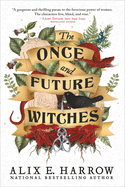
Alix E. Harrow (The Ten Thousand Doors of January) enters the ranks of the growing feminist witch genre with The Once and Future Witches, an expansive, angry and ultimately hopeful historical fantasy novel set in an alternate-history 1893 New Salem, 200 years after the (fictional) complete destruction of Salem.
The initially estranged Eastwood sisters represent three archetypal witches and women: the Maiden, the Mother and the Crone, though Harrow makes clear that every woman is not just one thing. Eldest sister and librarian Bella is the Crone, often found researching spells and acting as the voice of reason. Pregnant middle sister Agnes is the Mother, at times hesitant to enter or continue the fight. Much younger Juniper, half-feral and wildly optimistic, takes on the role of a warrior Maiden, murdering their abusive father and reuniting the sisters at the beginning of the novel; she is the glue that holds them together.
Harrow's world-building is intricate, and the plot is full of smaller battles and acts of rebellion, but her protagonists are complex women with clear motivations. The Once and Future Witches deals heavily with feminist themes, including women's suffrage, sexual harassment and legal oppression, but Harrow also works to broaden the scope beyond white feminism. Harrow's diverse cast of secondary characters are working toward equity in other spheres: the labor movement and unions, Black civil rights, sex work and immigrant and LGBTQ+ experiences.
And although Harrow never pretends that change is immediate or easy, in the world she's created, witching is inside everyone, meaning that the power to effect change is within the grasp of all. --Suzanne Krohn, editor, Love in Panels

